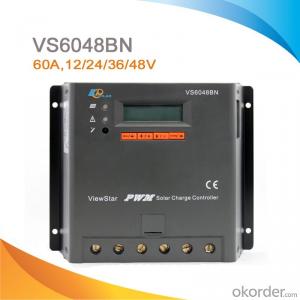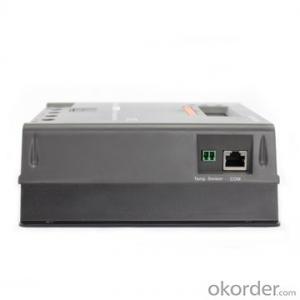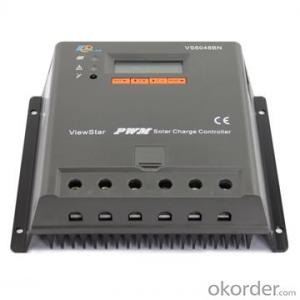LCD Display PWM Solar Charge Controller /Regulator 60A 12/24/36/48V,VS6048BN
- Loading Port:
- Tianjin
- Payment Terms:
- TT or LC
- Min Order Qty:
- -
- Supply Capability:
- 10000 pc/month
OKorder Service Pledge
OKorder Financial Service
You Might Also Like
Features:
·Excellent EMC design
·32 bit MCU with high speed
·High efficient Series PWM charging
·Four battery type options: Sealed, Gel, Flooded, and USER
·Intelligent lighting and timer control for solar lighting system
·12 bit A/D high-precision sampling to ensure accuracy
·Use MOSFET as electronic switch
·Full control parameters setting and modification, diversified load control mode
·Humanized design of browser interface, undertake every operating conveniently
·Temperature compensation
·Adopt graphics dot-matrix LCD screen and HMI (human-machine interface) with 4 buttons,integrated menu displaying and operation
·Energy statistics function
·RS485 ports with MODBUS communication protocol
·Optional PC monitoring software and remote meter for real-time monitoring and battery management parameter setting
·Field upgradable firmware
Electronic Protections:
·PV short circuit protection
·PV reverse polarity protection
·Battery overcharge protection
·Battery over discharge protection
·Battery reverse polarity protection
·Load overload protection
·Load short circuit protection
·Overheating protection
Specification:
Nominal system voltage | 12/24/36/48V auto work | |||
Rated battery current | 20A | 30A | 45A | 60A |
Rated load current | 20A | 30A | 45A | 60A |
Max. battery voltage | 64V | |||
Equalize charging voltage | Sealed: 14.6V, Flooded: 14.8V, User-defined: 9~17V | |||
Boost charging voltage | Gel: 14.2V, Sealed: 14.6V, Flooded: 14.8V, User-defined: 9~17V | |||
Float charging voltage | Gel /Sealed /Flooded: 13.8V, User-defined: 9~17V | |||
Low voltage reconnect voltage | Gel /Sealed /Flooded: 12.6V, User-defined: 9~17V | |||
Low voltage disconnect voltage | Gel /Sealed /Flooded: 11.1V, User-defined: 9~17V | |||
Self-consumption | ≤15mA(12V); ≤10mA(24V); ≤9mA(36V); ≤8mA(48V) | |||
Grounding | Common negative | |||
Temp. compensation | -3mV/°C/2V | |||
Relative humidity | 10%~90% Non-condensation | |||
Communication | RS485 / RJ45 interface | |||
LCD temperature | -20°C ~ +70°C | |||
Working temperature | -25°C ~ +55°C | |||
Humidity | ≤95% N.C. | |||
Enclosure | IP30 | |||
Overall dimension | 200x103x58mm | 201x109x59mm | 205x119x67mm | 205x174x64mm |
Terminals | 16mm2 | 35mm2 | 35mm2 | 35mm2 |
Net weight | 0.7kg | 0.9kg | 1.2kg | 1.5kg |
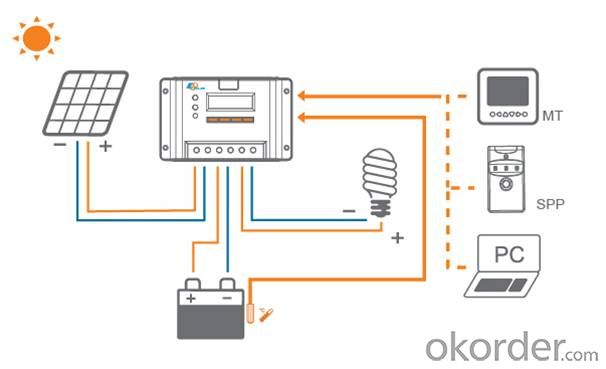
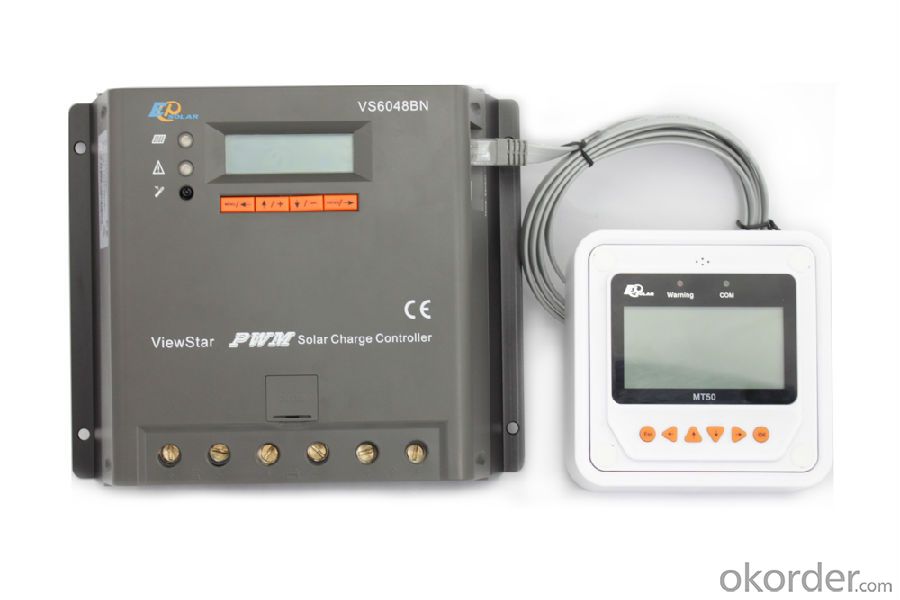

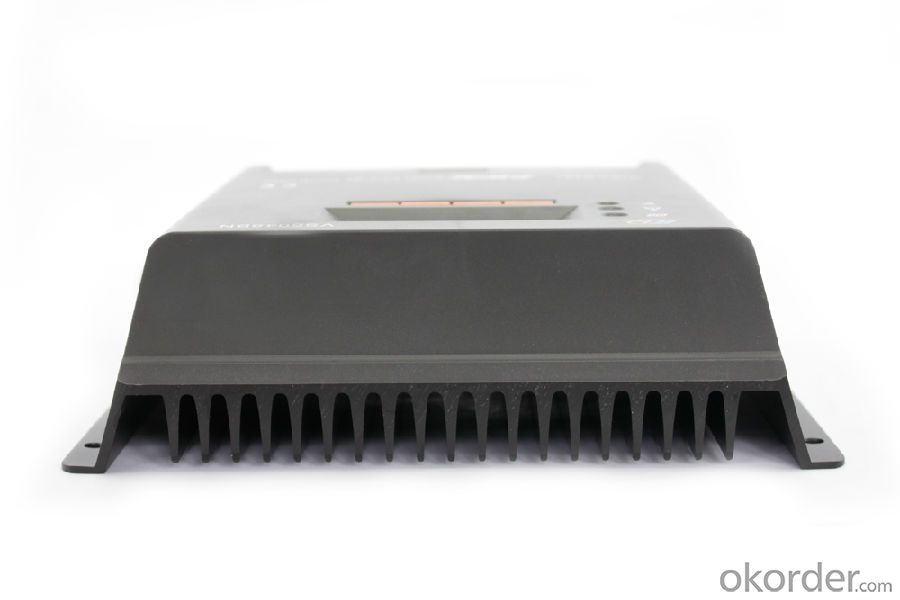
FAQ:
Q1. What is the voltage?
A1. Our 45/60A solar charge controller is 12/24/36/48V auto work.
Q2. What is the difference between MPPT&PWM?
A2. MPPT has higher efficiency, it can track the max power point and won't waste energy.
Q3. What is the efficiency of the MPPT controller?
A3. MPPT>99%, peak conversion efficiency>98%.
Q4. What is the waranty of product?
A4. 12 months.
- Q:How do I prevent undercharging of batteries with a solar controller?
- To prevent undercharging of batteries with a solar controller, there are a few key steps you can follow: 1. Select the correct solar controller: Ensure that you have a solar charge controller that is specifically designed for your battery type. Different types of batteries require different charging profiles, and using the wrong controller can result in undercharging or overcharging. 2. Properly size the solar array: Make sure that the size of your solar array (the total wattage of your solar panels) is sufficient to meet the energy needs of your battery system. If the solar array is too small, it may not generate enough power to fully charge the batteries, leading to undercharging. 3. Set the correct charging parameters: Most solar charge controllers have adjustable charging parameters such as voltage set points and charging algorithms. Consult the manufacturer's instructions or user manual to determine the optimal settings for your battery type, and configure the controller accordingly. 4. Monitor battery voltage and state of charge: Regularly check the battery voltage and state of charge using a battery monitor or voltmeter. This will allow you to determine if the batteries are being properly charged. If you notice that the voltage is consistently low or the state of charge is not increasing as expected, it may indicate undercharging. 5. Consider temperature compensation: Some solar controllers offer temperature compensation features, which adjust the charging parameters based on the ambient temperature. This can help prevent undercharging in extreme hot or cold conditions, as battery charging efficiency can be affected by temperature. 6. Regularly maintain and clean your solar panels: Keep your solar panels clean and free from debris to maximize their efficiency. Dust, dirt, or shading can reduce the amount of power generated, which may result in undercharging. By following these steps, you can significantly reduce the risk of undercharging your batteries with a solar controller and ensure they are properly charged for optimal performance and longevity.
- Q:Can a solar controller be used with a solar-powered data center?
- Yes, a solar controller can be used with a solar-powered data center. A solar controller is responsible for regulating the charging and discharging of batteries in a solar power system. In a solar-powered data center, the solar controller would play a crucial role in managing the flow of power from the solar panels to the batteries and ensuring the efficient utilization of solar energy.
- Q:Can a solar controller be used in a solar-powered deep-sea mining system?
- Yes, a solar controller can be used in a solar-powered deep-sea mining system. The solar controller is responsible for regulating and optimizing the charging process of the batteries, which store the energy generated by the solar panels. In a deep-sea mining system, where the availability of sunlight might be limited, the solar controller can efficiently manage the charging and discharging of the batteries, ensuring a stable power supply for the mining equipment and systems.
- Q:Can a solar controller be used with flooded batteries?
- Yes, a solar controller can be used with flooded batteries. In fact, it is recommended to use a solar controller with flooded batteries to ensure proper charging and prevent overcharging, which can damage the batteries. The solar controller regulates the charging current and voltage from the solar panels, protecting the flooded batteries and extending their lifespan.
- Q:How long does a solar controller typically last?
- A solar controller typically lasts for about 10 to 15 years, depending on the quality of the controller and how well it is maintained.
- Q:What is the lifespan of a typical solar controller?
- The duration of a typical solar controller's life can differ based on various factors such as the controller's quality, brand, and specific model. On average, a well-crafted solar controller can endure anywhere from 5 to 15 years. Nevertheless, it is essential to recognize that this estimation serves as a general guideline rather than a guarantee. The lifespan of a solar controller is impacted by a range of elements including the environmental conditions it encounters, the level of maintenance and care it receives, and the workload it handles. Extreme temperatures, humidity, and exposure to severe weather conditions can potentially reduce the controller's lifespan. Furthermore, improper maintenance or excessive workload can also affect its longevity. To maximize the lifespan of a solar controller, it is advisable to select a reputable brand and model, ensure proper installation, and adhere to the manufacturer's guidelines for maintenance and usage. Regular inspections, cleaning, and routine maintenance can help identify any potential issues and prevent premature failure. It is important to note that advancements in technology are continually enhancing the lifespan of solar controllers. Newer models often possess improved durability and reliability, which can extend their lifespan beyond the average estimate. Therefore, staying up-to-date with the latest innovations in solar controller technology is always beneficial to ensure the longest possible lifespan for your system.
- Q:How do I determine the maximum solar panel input voltage for a solar controller?
- To determine the maximum solar panel input voltage for a solar controller, you need to consider the specifications of the solar controller and the solar panels you are using. First, check the datasheet or user manual of the solar controller. Look for the maximum input voltage rating mentioned in the specifications section. This rating indicates the highest voltage that the controller can safely handle without causing damage or malfunctions. It is important to ensure that the solar panel's voltage does not exceed this maximum input voltage rating of the controller. Next, find the open circuit voltage (Voc) of your solar panels. This is the voltage produced by the panels when there is no load connected. You can usually find this information on the datasheet or product specification of the solar panels. Compare the open circuit voltage of your solar panels with the maximum input voltage rating of the solar controller. If the voltage of the solar panels is below or equal to the maximum input voltage rating of the controller, then the solar controller can safely handle the panels. However, if the voltage of your solar panels exceeds the maximum input voltage rating of the solar controller, you have a few options. One option is to use a step-down voltage converter or a voltage regulator to reduce the panel voltage to a level that is within the range supported by the controller. Another option is to consider using a different solar controller with a higher maximum input voltage rating that can handle the voltage of your solar panels. Ultimately, it is crucial to ensure that the solar panel voltage is within the limits specified by the solar controller to prevent any damage to the controller and ensure optimal performance of your solar power system.
- Q:How do I connect solar panels to a solar controller?
- Follow these steps to connect your solar panels to a solar controller: 1. Begin by positioning your solar panels in a location that receives maximum sunlight throughout the day. Make sure they are securely mounted and properly angled for optimal sun exposure. 2. Locate the positive and negative terminals on your solar panels, which are typically labeled as "+" and "-". Consult the user manual or markings on the panels for accurate identification. 3. Once you have found the terminals, make the connections. Attach the positive terminal of the first solar panel to the positive input terminal of the solar controller using a solar panel cable or wire with appropriate connectors. Repeat this step for the negative terminals, connecting the negative terminal of the first solar panel to the negative input terminal of the solar controller. 4. If you have multiple solar panels, follow the solar controller's specifications and your energy requirements to determine whether to connect them in series or parallel. In series connections, link the positive terminal of one panel to the negative terminal of the next panel. In parallel connections, connect all positive terminals together and all negative terminals together. 5. Double-check all the connections to ensure they are secure. Loose connections can result in power loss and inefficiency. 6. Finally, connect the solar controller to your battery bank or power inverter. Most solar controllers have separate terminals for battery connections, labeled as "+" and "-". Connect the positive terminal of the battery to the positive output terminal of the solar controller, and the negative terminal of the battery to the negative output terminal of the solar controller. 7. After completing the connections, power on the solar controller and monitor the charging status. The solar controller will regulate the power flow from the solar panels to the battery bank, ensuring efficient charging and preventing overcharging. Always refer to the user manual provided with your specific solar panels and solar controller for any manufacturer-specific instructions or guidelines.
- Q:How does a solar controller handle battery equalization charging?
- A solar controller handles battery equalization charging by monitoring the voltage levels of each individual battery within a bank. When the controller detects that the batteries have become imbalanced, it initiates an equalization charging process. This involves delivering a controlled amount of higher voltage to the batteries in order to restore their balance. The solar controller ensures that the equalization charging process is done safely and efficiently, preventing overcharging or damaging the batteries.
- Q:Can a solar controller be used with solar-powered outdoor signage?
- Yes, a solar controller can be used with solar-powered outdoor signage. A solar controller is necessary to regulate and optimize the charging of the batteries used in solar-powered systems. It helps to prevent overcharging, over-discharging, and other potential issues. Therefore, using a solar controller is essential for maintaining the efficiency and longevity of the batteries powering the outdoor signage.
1. Manufacturer Overview |
|
|---|---|
| Location | |
| Year Established | |
| Annual Output Value | |
| Main Markets | |
| Company Certifications | |
2. Manufacturer Certificates |
|
|---|---|
| a) Certification Name | |
| Range | |
| Reference | |
| Validity Period | |
3. Manufacturer Capability |
|
|---|---|
| a)Trade Capacity | |
| Nearest Port | |
| Export Percentage | |
| No.of Employees in Trade Department | |
| Language Spoken: | |
| b)Factory Information | |
| Factory Size: | |
| No. of Production Lines | |
| Contract Manufacturing | |
| Product Price Range | |
Send your message to us
LCD Display PWM Solar Charge Controller /Regulator 60A 12/24/36/48V,VS6048BN
- Loading Port:
- Tianjin
- Payment Terms:
- TT or LC
- Min Order Qty:
- -
- Supply Capability:
- 10000 pc/month
OKorder Service Pledge
OKorder Financial Service
Similar products
New products
Hot products
Hot Searches
Related keywords
